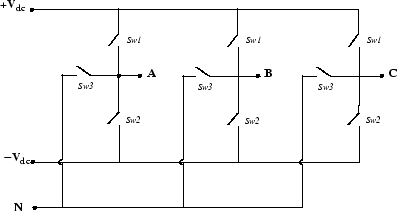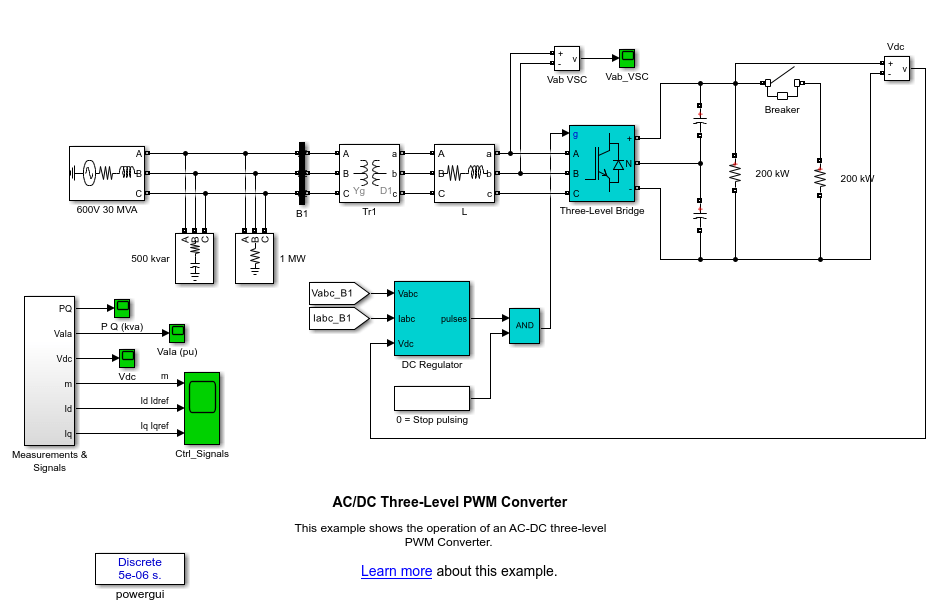Three-Level Bridge
Implement three-level neutral point clamped (NPC) power converter with selectable topologies and power switching devices
Libraries:
Simscape /
Electrical /
Specialized Power Systems /
Power Electronics
Description
The Three-Level Bridge block implements a three-level power converter that consists of one, two, or three arms of power switching devices. Each arm consists of four switching devices along with their antiparallel diodes and two neutral clamping diodes as shown in the figure below.

The type of power switching device (IGBT, GTO, MOSFET, or ideal switch) and the number of arms (one, two, or three) are selectable from the dialog box. When the ideal switch is used as the switching device, the Three-Level Bridge block implements an ideal switch bridge having a three-level topology as shown in the following figure.

Examples
Assumptions and Limitations
This block does not model turn-on and turn-off times (Fall time, Tail time) of power switching devices.
Ports
Input
g — Gating signal to control converter
vector of 4, 8, or 12 elements
Vectorized gating signal that contains pulses to control the power electronic devices of the bridge. The length of the input vector depends on the number of arm you specified for the bridge topology.
Number of bridge arms | Pulse Vector of Input g |
|---|---|
1 |
|
2 |
|
3 |
|
Note
In the case of the ideal switch converter, the Q1 pulse is sent to Sw1, the Q4 pulse to Sw2, and a logical AND operation is performed on the Q2 and Q3 pulses and the result sent to Sw3.
Conserving
A — Phase A terminal
specialized electrical
Specialized electrical conserving port associated with the phase A terminal.
B — Phase B terminal
specialized electrical
Specialized electrical conserving port associated with the phase B terminal.
C — Phase C terminal
specialized electrical
Specialized electrical conserving port associated with the phase C terminal.
N — Neutral terminal
specialized electrical
Specialized electrical conserving port associated with the neutral terminal.
+ — Positive terminal
specialized electrical
Specialized electrical conserving port associated with the positive terminal.
- — Negative terminal
specialized electrical
Specialized electrical conserving port associated with the negative terminal.
Parameters
To edit block parameters interactively, use the Property Inspector. From the Simulink® Toolstrip, on the Simulation tab, in the Prepare gallery, select Property Inspector.
Number of bridge arms — Number of bridge arms
3 (default) | 1 | 2
Number of bridge arms.
Snubber resistance Rs (Ohms) — Snubber resistance
1e5 (default) | positive scalar
Snubber resistance, in ohms. Set the snubber resistance to
inf to eliminate the snubbers.
Snubber capacitance Cs (F) — Snubber capacitance
inf (default) | nonnegative scalar
Snubber capacitance, in farads. Set the Snubber
capacitance Cs (F) parameter to 0 to
eliminate the snubbers, or to inf to get a resistive
snubber.
To eliminate snubbers in all power electronic devices when using a continuous solver, select the Disable snubbers in switching devices option in the Powergui Preferences tab.
When your system is discretized, you can simulate power electronic devices with virtually no snubbers by specifying purely resistive snubbers with a very large resistance, thus producing negligible leakage currents. The bridge operates satisfactorily with purely resistive snubbers.
Power electronic device — Power electronic device in bridge
GTO / Diodes (default) | MOSFET / Diodes | IGBT / Diodes | Ideal switches
Type of power electronic device to use in the bridge
Internal resistance Ron (Ohms) — Forward voltage across diode
1e-3 (default) | nonnegative scalar
Internal resistance of the selected devices and diodes, in ohms (Ω).
Forward voltages [Device Vf(V), Diode Vfd(V)] — Forward voltage across diode
[ 0 0 ] (default) | vector of two nonnegative values
Forward voltage of the selected devices (for GTO or IGBT only) and of the anti-parallel and clamping diodes, in volts
Dependencies
To enable this parameter, set Power electronic
device to GTO/Diodes or
IGBT / Diodes.
Measurements — Forward voltage across diode
None (default) | All device currents | Phase-to-Neutral and DC voltages | All voltages and currents
Select All device currents to measure the
current flowing through all the components (switching devices and diodes).
If the snubber devices are defined, the measured currents are those flowing
through the power electronic devices only.
Select Phase-to-Neutral and DC voltages to
measure the terminal voltages (AC and DC) of the Three-Level Bridge block.
Select All voltages and currents to measure all
voltages and currents defined for the Three-Level Bridge block.
Place a Multimeter block in your model to display the selected measurements during the simulation. In the Available Measurement list box of the Multimeter block, the measurement is identified by a label followed by the block name.
Measurement | Label (for GTO, IGBT, MOSFET Devices) |
|---|---|
Device currents |
|
Terminal voltages |
|
Measurement | Label (for Ideal Switch Device) |
|---|---|
Device currents |
|
Terminal voltages |
|
Extended Capabilities
C/C++ Code Generation
Generate C and C++ code using Simulink® Coder™.
Version History
Introduced before R2006a
See Also
MATLAB Command
You clicked a link that corresponds to this MATLAB command:
Run the command by entering it in the MATLAB Command Window. Web browsers do not support MATLAB commands.

Select a Web Site
Choose a web site to get translated content where available and see local events and offers. Based on your location, we recommend that you select: .
You can also select a web site from the following list
How to Get Best Site Performance
Select the China site (in Chinese or English) for best site performance. Other MathWorks country sites are not optimized for visits from your location.
Americas
- América Latina (Español)
- Canada (English)
- United States (English)
Europe
- Belgium (English)
- Denmark (English)
- Deutschland (Deutsch)
- España (Español)
- Finland (English)
- France (Français)
- Ireland (English)
- Italia (Italiano)
- Luxembourg (English)
- Netherlands (English)
- Norway (English)
- Österreich (Deutsch)
- Portugal (English)
- Sweden (English)
- Switzerland
- United Kingdom (English)
Asia Pacific
- Australia (English)
- India (English)
- New Zealand (English)
- 中国
- 日本Japanese (日本語)
- 한국Korean (한국어)
